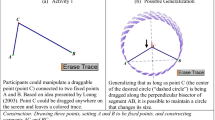Abstract
What makes Dynamic Geometry Environment (DGE) a powerful mathematical knowledge acquisition microworld is its ability to visually make explicit the implicit dynamism of thinking about mathematical geometrical concepts. One of DGE’s powers is to equip us with the ability to retain the background of a geometrical configuration while we can selectively bring to the fore dynamically those parts of the whole configuration that interest us. That is, we can visually study the variation of an aspect of a DGE figure while keeping other aspects constant, hence anticipating the emergence of invariant patterns. The aim of this paper is to expound the epistemic value of variation of the Dragging tool in DGE in mathematical discovery. Functions of variation (contrast, separation, generalization, fusion) proposed in Marton’s theory of learning and awareness will be used as a framework to develop a discernment structure which can act as a lens to organize and interpret dragging explorations in DGE. Such a lens focuses very strongly on mathematical aspects of dragging in DGE and is used to re-interpret known dragging modalities (e.g., Arzarello et al.) in a potentially more mathematically-relevant way. The exposition will centre about a specific geometrical problem in which two dragging trajectories are mapped out, consequently resulting in a DGE theorem and a visual theorem. In doing so, a new spectral dragging strategy will be introduced that literally allows one to see the drag mode in action. A model for the lens of variation in the form of a discernment nest structure is proposed as a meta-tool to interpret dragging experiences or as a meta-language to relate different dragging analyses which consequently might give rise to pedagogical and epistemological implications.




















Similar content being viewed by others
References
Arzarello, F., Olivero, F., Paola, D., & Robutti, O. (2002). A cognitive analysis of dragging practices in Cabri environments. ZDM. Zentralblatt für Didaktik der Mathematik, 34(3), 66–72. doi:10.1007/BF02655708.
Davis, P. (1993). Visual Theorem. Educational Studies in Mathematics, 24, 333–344. doi:10.1007/BF01273369.
Falcade, R., Laborde, C., & Mariottie, M. A. (2007). Approaching functions: Cabri tools as instruments of semiotic mediation. Educational Studies in Mathematics, 66, 317–333. doi:10.1007/s10649-006-9072-y.
Gärdenfors, P. (1988). Knowledge in flux: Modeling the dynamics of epistemic states. MIT Press: A Bradford Book.
Hegedus, S. (2005). Dynamic representations: a new perspective on instrumental genesis (Paper presented at CERME 2005, Sant Feliu de Guíxols, Spain)
Hölzl, R. (1996). How does ‘dragging’ affect the learning of geometry. International Journal of Computers for Mathematical Learning, 1, 169–187. doi:10.1007/BF00571077.
Ihde, D. (1986). Experimental Phenomenology: An Introduction. Albany: State University of New York Press.
Jackiw, N. (2001). The Geometer’s Sketchpad 4 [Computer Program]. San Francisco: Key Curriculum Press.
Jackiw, N. (2006). Mechanism and magic in the psychology of dynamic geometry. In N. Sinclair, D. Pimm & W. Higginson (Eds.), Mathematics and the Aesthetics: New Approaches to an Ancient Affinity (pp. 145–159). CMS Books in Mathematics, Springer Science + Business Media, LLC.)
Laborde, C. (2005). Robust and soft constructions: Two sides of the use of dynamics geometry environments. In Proceedings of the Tenth Asian Technology Conference in Mathematics. Korea National University of Education, Cheong-Ju, South Korea, pp. 22–35.
Leung, A. (2003). Dynamic geometry and the theory of variation. In N. A. Pateman, B. J. Doughherty, & J. T. Zillox (Eds.), Proceedings of PME 27: Psychology of Mathematics Education 27th International Conference Volume 3 (pp. 197–204). Honolulu: University of Hawaii.
Leung, A., & Chan, Y. C. (2006). Exploring necessary and sufficient conditions in dynamic geometry environment. The International Journal for Technology in Mathematics Education, 13(1), 37–43.
Leung, A., Chan, Y. C., & Lopez-Real, F. (2006). Instrumental genesis in dynamic geometry environments. In L. H. Son, N. Sinclair, J. B. Lagrange, & C. Hoyles (Eds.), Proceedings of the ICMI 17 Study Conference: Part 2 (pp. 346–353). Vietnam: Hanoi University of Technology.
Leung, A., & Lopez-Real, F. (2002). Theorem justification and acquisition in dynamic geometry: a case of proof by contradiction. International Journal of Computers for Mathematical Learning, 7, 145–165. doi:10.1023/A:1021195015288.
Lopez-Real, F., & Leung, A. (2006). Dragging as a conceptual tool in dynamic geometry environments. International Journal of Mathematical Education in Science and Technology, 37(6), 665–679. doi:10.1080/00207390600712539.
Mariotti, M. A. (2002). Influence of technologies advances on students’ maths learning. In L. English, M. Bartolini Bussi, G. Jones, R. Lesh, & D. Tirosh (Eds.), Handbook of international research in mathematics education (pp. 695–721). New Jersey: Lawrence Erbaum Associates.
Marton, F., & Booth, S. (1997). Learning and awareness. New Jersey: Lawrence Erlbaum Associates, INC, Publishers.
Marton, F., Runesson, U., & Tsui, A. B. M. (2004). The space of learning. In F. Marton & A. B. M. Tsui (Eds.), Classroom discourse and the space of learning (pp. 3–40). New Jersey: Lawrence Erlbaum Associates, INC Publishers.
Presmeg, N. (2006). Semiotics and the “connections” standard: significance of semiotics for teachers of mathematics. Educational Studies in Mathematics, 61, 163–182. doi:10.1007/s10649-006-3365-z.
Schattschneider, D., & King, J. (Eds.). (1997). Geometry turned on: dynamic software in learning, teaching and research. Washington, DC: The Mathematical Assiciation of America.
Vérillon, P., & Rabardel, P. (1995). Cognition and artifacts: A contribution to the study of thought in relation to instrumented activity. European Journal of Psychology of Education, 10(1), 77–101.
Acknowledgements
I would like to thank Arthur Lee for introducing the Parametric Color function in Sketchpad to me which motivated the spectral dragging modality discussed in Sect. 3.5, Francis Lopez-Real and the reviewers for their very constructive comments in shaping the final version of this paper.
Author information
Authors and Affiliations
Corresponding author
Rights and permissions
About this article
Cite this article
Leung, A. Dragging in a Dynamic Geometry Environment Through the Lens of Variation. Int J Comput Math Learning 13, 135–157 (2008). https://doi.org/10.1007/s10758-008-9130-x
Received:
Accepted:
Published:
Issue Date:
DOI: https://doi.org/10.1007/s10758-008-9130-x




